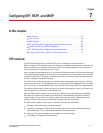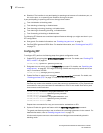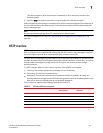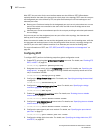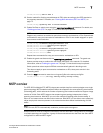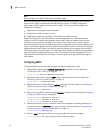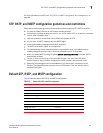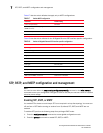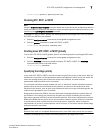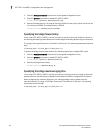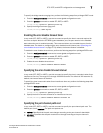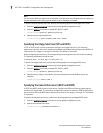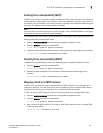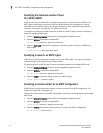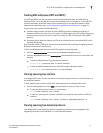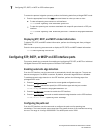
Converged Enhanced Ethernet Administrator’s Guide 65
53-1002163-02
STP, RSTP, and MSTP configuration and management
7
DRAFT: BROCADE CONFIDENTIAL
switch(config)#protocol spanning-tree rstp
Disabling STP, RSTP, or MSTP
NOTE
Using the no protocol spanning-tree command deletes the context and all the configurations defined
within the context or protocol for the interface, unless the spanning treeis explicity shutdown on the
interface by the spanning-tree shutdown command.
To disable STP, RSTP, or MSTP, perform the following steps from privileged EXEC mode. By default,
STP, RSTP, and MSTP are not enabled.
1. Enter the configure terminal command to access global configuration mode.
2. Enter the protocol command to disable STP, RSTP, or MSTP.
switch(config)#no protocol spanning-tree
Shutting down STP, RSTP, or MSTP globally
To shut down STP, RSTP, or MSTP globally, perform the following steps from privileged EXEC mode.
1. Enter the configure terminal command to access global configuration mode.
2. Enter the shutdown command to globally shutdown STP, RSTP, or MSTP. The shutdown
command below works in all three modes.
switch(conf-mstp)#shutdown
Specifying the bridge priority
In any mode (STP, RSTP, or MSTP), use this command to specify the priority of the switch. After you
decide on the root switch, set the appropriate values to designate the switch as the root switch. If a
switch has a bridge priority that is lower than all the other switches, the other switches
automatically select the switch as the root switch.
The root switch should be centrally located and not in a “disruptive” location. Backbone switches
typically serve as the root switch because they often do not connect to end stations. All other
decisions in the network, such as which port to block and which port to put in forwarding mode, are
made from the perspective of the root switch.
Bridge protocol data units (BPDUs) carry the information exchanged between switches. When all
the switches in the network are powered up, they start the process of selecting the root switch.
Each switch transmits a BPDU to directly connected switches. Each switch compares the received
BPDU to the BPDU that the switch sent. In the root switch selection process, if switch 1 advertises
a root ID that is a lower number than the root ID that switch 2 advertises, switch 2 stops the
advertisement of its root ID, and accepts the root ID of switch 1. The switch with the lowest bridge
priority becomes the root switch.
NOTE
Because each VLAN is in a separate broadcast domain, each VLAN must have its own root switch.
To specify the bridge priority, perform the following steps from privileged EXEC mode.



